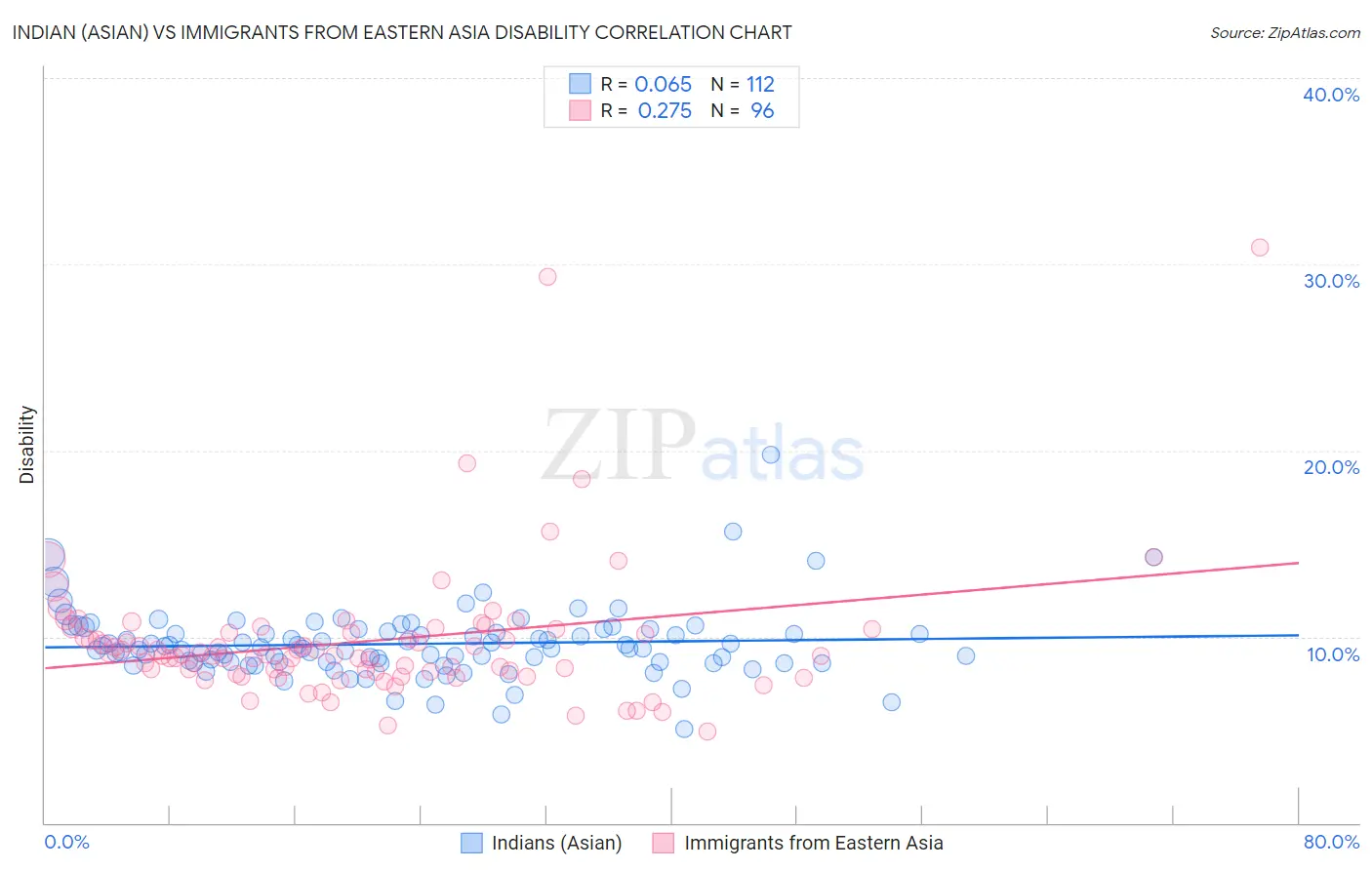Indian (Asian) vs Immigrants from Eastern Asia Disability
COMPARE
Indian (Asian)
Immigrants from Eastern Asia
Disability
Disability Comparison
Indians (Asian)
Immigrants from Eastern Asia
10.3%
DISABILITY
100.0/ 100
METRIC RATING
16th/ 347
METRIC RANK
10.2%
DISABILITY
100.0/ 100
METRIC RATING
13th/ 347
METRIC RANK
Indian (Asian) vs Immigrants from Eastern Asia Disability Correlation Chart
The statistical analysis conducted on geographies consisting of 495,278,900 people shows a slight positive correlation between the proportion of Indians (Asian) and percentage of population with a disability in the United States with a correlation coefficient (R) of 0.065 and weighted average of 10.3%. Similarly, the statistical analysis conducted on geographies consisting of 499,894,930 people shows a weak positive correlation between the proportion of Immigrants from Eastern Asia and percentage of population with a disability in the United States with a correlation coefficient (R) of 0.275 and weighted average of 10.2%, a difference of 0.98%.

Disability Correlation Summary
| Measurement | Indian (Asian) | Immigrants from Eastern Asia |
| Minimum | 5.0% | 4.9% |
| Maximum | 19.7% | 30.9% |
| Range | 14.7% | 26.0% |
| Mean | 9.6% | 9.8% |
| Median | 9.4% | 9.0% |
| Interquartile 25% (IQ1) | 8.6% | 8.1% |
| Interquartile 75% (IQ3) | 10.3% | 10.3% |
| Interquartile Range (IQR) | 1.7% | 2.2% |
| Standard Deviation (Sample) | 1.9% | 3.8% |
| Standard Deviation (Population) | 1.9% | 3.8% |
Demographics Similar to Indians (Asian) and Immigrants from Eastern Asia by Disability
In terms of disability, the demographic groups most similar to Indians (Asian) are Okinawan (10.3%, a difference of 0.070%), Immigrants from Iran (10.3%, a difference of 0.070%), Immigrants from Korea (10.2%, a difference of 0.37%), Burmese (10.4%, a difference of 1.1%), and Immigrants from Pakistan (10.4%, a difference of 1.1%). Similarly, the demographic groups most similar to Immigrants from Eastern Asia are Immigrants from Israel (10.1%, a difference of 0.21%), Iranian (10.1%, a difference of 0.46%), Immigrants from China (10.1%, a difference of 0.47%), Immigrants from Korea (10.2%, a difference of 0.60%), and Okinawan (10.3%, a difference of 0.91%).
| Demographics | Rating | Rank | Disability |
| Thais | 100.0 /100 | #4 | Exceptional 9.7% |
| Immigrants | Bolivia | 100.0 /100 | #5 | Exceptional 9.9% |
| Immigrants | South Central Asia | 100.0 /100 | #6 | Exceptional 9.9% |
| Immigrants | Singapore | 100.0 /100 | #7 | Exceptional 10.0% |
| Bolivians | 100.0 /100 | #8 | Exceptional 10.0% |
| Immigrants | Hong Kong | 100.0 /100 | #9 | Exceptional 10.0% |
| Immigrants | China | 100.0 /100 | #10 | Exceptional 10.1% |
| Iranians | 100.0 /100 | #11 | Exceptional 10.1% |
| Immigrants | Israel | 100.0 /100 | #12 | Exceptional 10.1% |
| Immigrants | Eastern Asia | 100.0 /100 | #13 | Exceptional 10.2% |
| Immigrants | Korea | 100.0 /100 | #14 | Exceptional 10.2% |
| Okinawans | 100.0 /100 | #15 | Exceptional 10.3% |
| Indians (Asian) | 100.0 /100 | #16 | Exceptional 10.3% |
| Immigrants | Iran | 100.0 /100 | #17 | Exceptional 10.3% |
| Burmese | 100.0 /100 | #18 | Exceptional 10.4% |
| Immigrants | Pakistan | 100.0 /100 | #19 | Exceptional 10.4% |
| Immigrants | Venezuela | 100.0 /100 | #20 | Exceptional 10.4% |
| Asians | 100.0 /100 | #21 | Exceptional 10.4% |
| Immigrants | Sri Lanka | 100.0 /100 | #22 | Exceptional 10.5% |
| Immigrants | Asia | 100.0 /100 | #23 | Exceptional 10.5% |
| Venezuelans | 100.0 /100 | #24 | Exceptional 10.5% |